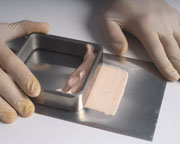Indoor air pollution poses a serious threat to public health. Products and materials emit chemicals and particles into the air that may cause health effects ranging from minor ailments like headaches, nosebleeds and throat irritation to more serious diseases like asthma or cancer.

Formaldehyde, a Carcinogen Found in Some Adhesives
One of the most common pollutants found in indoor air is formaldehyde, a carcinogen often emitted by pressed-wood products, adhesives and fabrics It can cause severe headaches, sensory irritation, nausea, rashes and cancer. The state of California EPA OEHHA has identified up to 60 hazardous substances, including formaldehyde, and the project specifications for the Capitol Area East End Complex has established maximum modeled indoor-air chemical concentrations for those compounds and formaldehyde."The knowledge we'll gain from this project will form the basis of future guidelines for indoor-air emissions and chemical concentrations," said Anthony Bernheim, FAIA, who is principal of Green Design at SMWM, a San Francisco architecture, interiors, planning and graphic-design firm. "Such specifications will be part of an increasing number of future building projects across the United States."
Product-emissions testing has been around for a while, but very few manufacturers know their products' chemical emissions or how to accurately test for them. Air Quality Sciences (AQS), an ISO 9002-accredited and California-approved laboratory, offers product-emissions testing for the California specifications and helps manufacturers better understand and address regulations on indoor air quality. Many federal agencies and some states have already adopted guidelines for indoor air quality, and product chemical-emissions profiles could soon be required for every procurement proposal.


